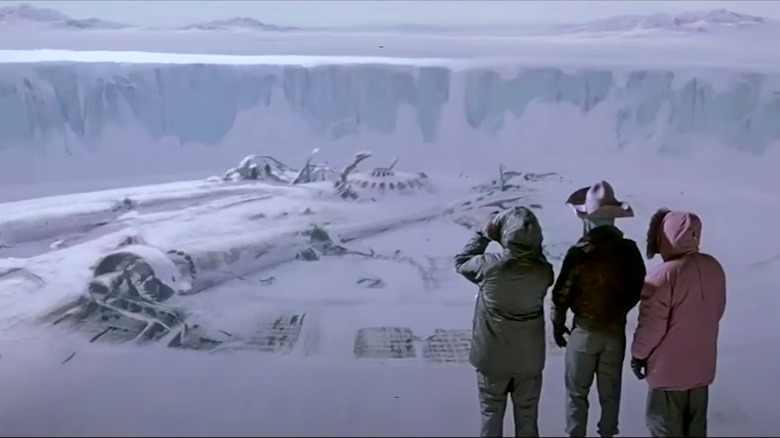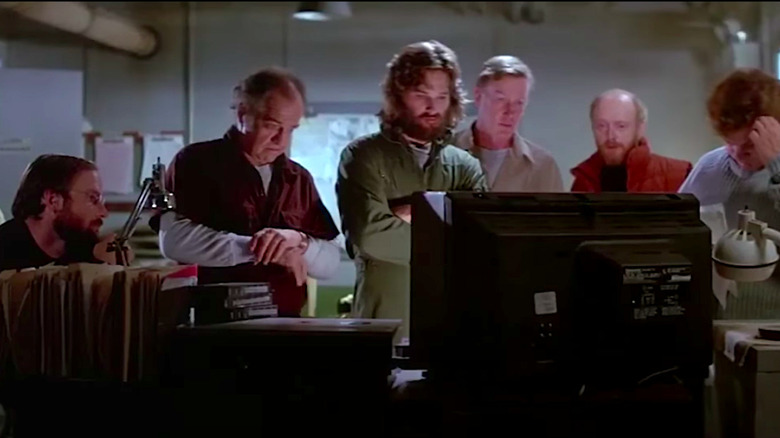The Thing Crew Risked Their Lives For One Shot Of The Spaceship
Everything would have been fine if only those Norwegians hadn't blown up the ice that buried a 100,000-year-old alien spaceship. But, like most of humanity, curiosity got the better of them and they unleashed an alien species hellbent on taking over the world. On a superficial level (there's a prequel that goes into way more depth about this whole thing), this is basically the backstory for the plot of John Carpenter's 1982 science fiction horror movie "The Thing" in which a scrappy team of American arctic explorers discovers they are under attack by a shape-shifting alien that wants to assimilate into human form and bring an end to the human race.
This movie has it all. Suspense and paranoia (sorry, Blair. I simply cannot let you out of the tool shed on account of the fact that you, uh, built a baby spaceship ...? ), killer practical effects (who doesn't love a good carnivorous, hand-chomping, stomach mouth?), Kurt Russell (love you, dude), and an insane ending that will bother you until the end of time (it's you, Childs. It. Is. You.).
It also has aliens (duh), and an entire scene in which the American researchers discover the remains of that same buried spaceship the Norwegians just couldn't leave alone. It's one of the few shots where we get to see some of the men operating outside of the confines of the research station, and the enormity of the ship partially submerged in the ice is very impressive. There's no doubt that MacReady and the rest of the American team are in a lot of danger as they poke around the ship and try to piece together what is happening to them. But the more exciting thing is that the film crew that was actually making the movie was also in a lot of danger as they worked to film those pivotal spaceship scenes.
Becoming a thing isn't the only way to die in the arctic
In the documentary "The Making of 'The Thing,'" production designer John Lloyd talks a little bit about how they filmed those impressive spaceship scenes for the film. It turns out that only a portion of the actual ship was made. It was transported by helicopter to Alaska where filming was taking place, and even though the rest of the ship was added in after the fact by the matte artist Albert Whitlock, the process of filming in the actual snow was still risky. As he put it:
"The big problem is getting the spaceship there. We had to hook up to a helicopter and drop it, and then we went to shoot the matte shots and Albert wanted to wait until evening, you know, 'Let's get the magic hour.' And we waited too long and the helicopter came, was waiting, and we waited, we waited and finally Albert says, 'Once more,' and the guy said, 'Now look this is it we're leaving.' And so I never- they all had this heavy gear and we try to get in a helicopter, I couldn't get the door shut, so regardless of that we took off..."
When it came time to shoot, Whitlock insisted that they wait until the light was just right which in this case meant hanging around into the early evening. The problem, as explained by Lloyd, is that the crew waited around too long, jeopardizing their safety. When Whitlock wanted to do one more take, the pilot of their helicopter told them they had to leave immediately. Not wanting to risk their lives, the crew packed up and started their journey back to civilization. What they didn't realize was that they were running low on fuel.
Lloyd explains the exact moment when the pilot realized their situation saying, "It was the end of the day and then the [pilot] gets partway toward the camp, he said 'My god I think I'm going to run out of fuel,' and then I say, 'Well if we run out of fuel what'll happen?' He said, 'We'll just land and spend the night.' I could imagine spending the night in this helicopter with six or eight people!"
Thankfully though, the crew was able to safely make it back to camp without having to partake in an impromptu arctic slumber party. Still, the pilot wasn't as cool about the whole thing as the rest of the crew. "We finally made it back and everybody was happy," says Lloyd. "Except the helicopter pilot. He said we really didn't realize, really, what kind of trouble we were in. But again, ignorance is bliss." And I suppose if you think about "The Thing" in those terms, maybe becoming an assimilation wouldn't be that bad, after all.

